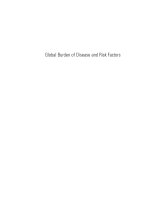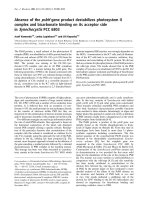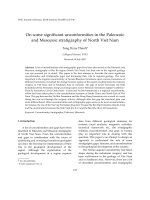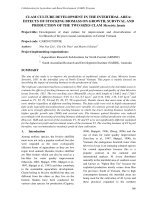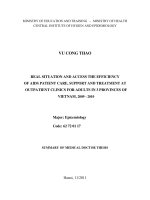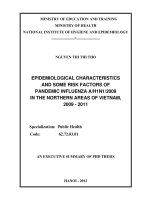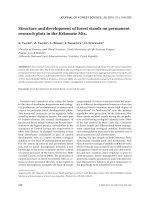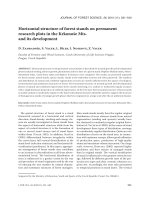epidemiology of, and risk factors on pandemic influenza ah1n12009 in the northern area of vietnam, 2009 - 2011
Bạn đang xem bản rút gọn của tài liệu. Xem và tải ngay bản đầy đủ của tài liệu tại đây (646.47 KB, 27 trang )
MINIMINISTRY OF EDUCATION AND TRAINING
MINISTRY OF HEALTH
NATIONAL INSTITUTE OF HYGIENE AND EPIDEMIOLOGY
*
NGUYEN THI THI THO
EPIDEMIOLOGICAL CHARACTERISTICS
AND SOME RISK FACTORS OF
PANDEMIC INFLUENZA A/H1N1/2009
IN THE NORTHERN AREAS OF VIETNAM,
2009 - 2011
Specialization: Public Health
Code: 62.72.03.01
AN EXECUTIVE SUMMARY OF PhD THESIS
HANOI - 2012
THE THESIS HAS BEEN COMPLETED IN
NATIONAL INSTITUTE OF HYGIENE AND EPIDEMIOLOGY
Scientific supervisors:
1. Assoc. Prof. Nguyen Tran Hien, PhD.
2. Dr. Tran Nhu Duong, PhD.
Opponent 1: Prof. PhD. Truong Viet Dung
Opponent 2:
Opponent 3:
The thesis shall be defended in the National Doctorate Thesis Grading Committee
established by the Decision No. 404/QD – VSDTTƯ dated 19
th
November, 2012, at:
NATIONAL INSTITUTE OF HYGIENE AND EPIDEMIOLOGY
At: 9h00, 19
th
October, 2012
This thesis is available to access at:
- National Library;
- Library of National Institute of Hygiene and Epidemiology.
RATIONALE
Influenza is an acute infectious disease caused by influenza viruses
that attacks mainly the upper respiratory tract infections, but can lead to
severe pneumonia and even death if the patients are not detected and
treated in time. Influenza is still a public health threat due to their rapidly
spreading and causing a pandemic. Influenza pandemics generally occur
suddenly and cause heavy losses for people and society, including:
significant increase in the number of cases and deaths associated with
influenza; overloaded health systems with prevention and treatment
activities; a decline in economic activities and cessation of educational
activities.
In the spring 2009, a new strain of the influenza A/H1N1 virus
appeared worldwide, which had shown the ability to cause a pandemic. On
11 June 2009, the World Health Organization (WHO) officially declared
the outbreak of influenza A/H1N1 to be the first influenza pandemic of the
XXI century, named pandemic influenza A/H1N1/2009 (pH1N1/2009). Six
weeks later, this pandemic had spread to 168 countries/overseas
territories/communities on all five continents with approximately 162,380
cases and 1,153 deaths.
On 31 May 2009, with the recognition of the first case of the
pH1N1/2009 in Ho Chi Minh City, Vietnam became the 54
th
country to
confirm the appearance of the influenza pandemic related to the new strain
of the H1N1 influenza virus. The fist case in the north of Vietnam occurred
on 8 June 2009. Then this pandemic had rapidly spread to other
provinces/cities. In order to provide scientific evidences for effective
prevention activities, as well as to retain the important information about
the first pandemic influenza in the XXI century, the study
"Epidemiological characteristics and some risk factors of pandemic
influenza A/H1N1/2009 in the Northern areas of Vietnam, 2009 - 2011"
was conducted with two specific objectives:
1. To describe the epidemiological development and characteristics, and
to identify the attack rate of pH1N1/2009 in the Northern areas of
Vietnam, from 2009 to 2011.
2
2. To identify some risk factors of pH1N1/2009 in the Northern areas of
Vietnam, from 2009 to 2011.
PRACTICAL IMPLICATIONS AND NEW CONTRIBUTIONS
- Novelty: This research provides full information about the
epidemiological development and characteristics of cases, deaths, attack
rate, transmission pattern, and some risk factors of the pH1N1/2009.
This is the first time when the epidemiological information of influenza
pandemic is fully retained in our country.
- Applicability: The information on epidemiological characteristics of the
pH1N1/2009 will provide scientific basis and lessons learned for the
development of effective prevention strategies for other pandemics that
we will continue to undergo in the future.
THESIS STRUCTURE
The thesis comprises about 138 pages and is divided into following
sessions: Rationale (2 pages); Chapter 1 – Literature review (32 pages),
Chapter 2 – Methodology (20 pages); Chapter 3 – Results (40 pages);
Chapter 4 – Discussion (44 pages); Conclusions (2 pages); and
Recommendations (1 page). There are 19 tables, 20 charts, 2 figures and
135 references in the thesis.
CHAPTER 1 – LITURATURE REVIEW
1.1. Some epidemiological characteristics of human influenza
1.1.1. Virology
Structure of viruses: Influenza is caused by influenza viruses which
are genus of the Orthomyxoviridae family of viruses. These viruses are
classified into subtypes depending on which versions of two
different surface glycoprotein antigens: Hemagglutinin (HA) and
Neuraminidase (NA). A type-specific antigen (S-Antigen), the major
component of influenza visions’ core proteins, classifies influenza viruses
into type A, B or C. Only type A virus is responsible for influenza
epidemics and pandemics in human whereas type B virus affecting only
human, primarily children, normally causes milder diseases, but can lead to
outbreaks in the winter. There is no evidence that influenza C virus can
causes epidemics in humans.
3
Antigen changes of influenza viruses: Influenza A virus is one of the
most changeable viruses known with two ways of genetic material changes
called drift and shift:
- Antigenic drift: this process is due to random mutations in the genes
coding hemaglutinin. Antigenic drift is responsible for small seasonal
influenza outbreaks.
- Antigenic shift: The most important mechanism in antigenic shift is
reassortment. This process occurs when two or more strains of a
influenza virus, especially strains of different viruses like human
influenza virus and avian influenza virus, intrude into the same host
where genetic permutations occur to form a new subtype of influenza
virus. Antigenic drift is the cause of human influenza pandemics.
1.1.2. Source of infection and mode of transmission
Infected patients, and in some specific situations, infected poultry are
also recognized as source of disease. Influenza virus is transmitted from
infected person to others via respiratory tract and through direct or indirect
contact.
1.1.3. Susceptibility, immune response and resistance
Anyone can get influenza. After infection, the human body’s immune
system becomes resistant to the strain of virus. Only antibodies specific for
the viral surface glycoprotein antigens of this virus that person is infected
with. The protecting effect against influenza is likely to reduce or even lost
if there is a change in the antigens structure of new virus.
1.2. Influenza pandemics before the XXI century
Historically, influenza pandemics happened very long ago, only is
described, however, from the sixteenth century. In the twentieth century,
the world had witnessed three influenza pandemics with different scales
and levels. These pandemics were recognized more fully than the previous
pandemics by applying technology advancements. The basic
epidemiological characteristics of the influenza pandemics in the twentieth
century are summarized in the table below:
4
Table 1.1. Summarizes some of the characteristics of influenza
pandemics in the XX century
Pandemics
Started
place
Influenza
virus
Case
fatality
rate
Deaths
Affected a
g
e
groups
Spanish Flu
(1918 - 1919)
Non-
specific
A/H1N1 2 - 3%
20 - 50
million
Young
people
Asian Flu
(1957 - 1958)
South China A/H2N2 <0,2%
1 - 4
million
Children,
The elderly
Hong Kong Flu
(1968 - 1969)
South China A/H3N2 <0,2%
1 - 4
million
All age
groups
1.3. The pandemic influenza A/H1N1/2009 and some risk factors
1.3.1. Pandemic influenza A/H1N1/2009 in the world
Viral pathogen is pH1N1/2009 with an entirely new genome structure
and satisfying virological features of human influenza pandemic
mechanism. This new virus is a result of the reassortment, with captaining
genes from avian influenza, North American swine influenza, human
influenza, and two swine influenza viruses found in Asia and Europe.
The origin and development of the pandemic: the first appearance of
2009 pandemic influenza A/H1N1 is in North America in March 2009. On
11 June 2009, WHO has announced a level 6 influenza pandemic for the
first time after 41 years. Six weeks later, the pandemic had spread to 168
countries/overseas territories/communities on all five continents with
approximately 162,380 cases and 1,153 deaths. Fourteen months later, on
10 August 2010, WHO officially announced that 2009 pandemic influenza
A/H1N1 had moved into the post-pandemic period.
Some epidemiological characteristics: In the first phase, WHO
estimated the attack rate of pH1N1/2009 ranges from 22% to 33%.
Hospitalization rates were about 6% in Mexico, 2 - 5% in the U.S. and
Canada and 2% in the UK. Case fatality rate did not exceed 0.35%, and
highly increase in underlying medical conditions group, children, the
people aged 65 or more and pregnant women. Unlike seasonal influenza,
90% of severe cases and deaths of pH1N1/2009 did not occur in the elderly
group.
5
1.3.2. Risk factors and high-risk groups
Currently, there is not much research related to identifying risk factors
for influenza infections, especially for influenza pandemic. Regarding to
seasonal influenza, children under 5 years of age was at a 1.85 times (1.09 -
3.26) greater risk of influenza infections as compared to those aged 15
years and over. To contact with children under the age of 5 and children
aged 5 - 15 years old getting influenza increases the infection risk to 1.93
and 1.68 times in comparison with adult cases. For pH1N1/2009, age is
also a risk factor for the possibility of infection. A research in China shows
that the possibility of infection of the age group under 18 years was 15
times as high as that of the group aged 18 years and over. Besides this, a
study in Japan also concluded that people under 20 years of age has a
higher risk for influenza injection than others (OR = 7.9 [2.24 - 27.8]).
Some other factors, such as hand washing (OR = 0.11 [0.04 - 0.28]),
regularly opening windows in workplace (OR = 0.14 [0.05 - 0.39]) were
proven to be protective factors against influenza infection. Some other
studies also identified that occupational status are risk factors for influenza
pandemic.
CHAPTER 2 - METHODOLOY
Objective 1
2.1. To describe epidemiological development and characteristics of
pH1N1/2009 cases and deaths
2.1.1. Target groups
- Influenza like illness (ILI), suspected cases, confirmed cases,
clinical cases and deaths related to pH1N1/2009.
- Reports related to pH1N1/2009.
2.1.2.Time and places: The study was conducted from May, 2009 to May,
2011 in 28 provinces in the Northern areas.
2.1.3. Study method: Descriptive study
2.1.4. Sample size and sampling approach
- Description of epidemiological development: Select all of 2948
pH1N1/2009 confirmed cases recorded during the duration of the
study.
- Description of epidemiology of pH1N1/2009 cases: The sample size
was calculated by the following formula:
6
n = Z
2
1-
α
/2
p (1-p)
d
2
As a result, 1068 first confirmed cases were selected in the study.
- Description of epidemiology of pH1N1/2009 deaths: Select all
deaths related to pH1N1/2009 recorded.
2.1.5. Laboratory testing technique: pH1N1/2009 cases and deaths were
confirmed by RT-PCR technique.
2.1.6. Data collection method: Interviewing cases or relatives of deaths by
using structured questionnaires.
2.2. To identify attack rates of pH1N1/2009
2.2.1. Target groups: pH1N1/2009 outbreaks. In each outbreak, target
groups included all subjects, pH1N1/2009 infection cases, clinical
cases, confirmed cases.
2.2.2. Study places:
- In community: The outbreak occurred in the village number 3, Pha
Le Commune, Thuy Nguyen district, Hai Phong city.
- In school settings: The outbreaks occurred in Pha Le primary school;
Ethnic boarding high school in Muong Nhe district, Dien Bien
province and Specialization high school in Lao Cai province.
- In special contact- environment: The outbreak occurred in one
tourist group.
2.2.3. Study time: In each pH1N1/2009 outbreak, the duration of study
was from the onset day of the index case to 2 weeks after the onset
day of the last case.
2.2.4. Study method: Descriptive study
2.2.5. Sample size: One pH1N1/2009 outbreak in the community, 3
outbreaks in different kinds of schools, and 1 outbreak in tourist
group.
2.2.6. Laboratory testing technique
- Confirmation of first pH1N1/2009 cases by RT-PCR technique.
- Identification of pH1N1/2009 infection cases by Haemaglutination
Inhibition (HI) test.
7
2.2.7. Data collection method: Interviewing cases (clinical and confirmed
cases), infection cases by using structured questionnaires.
Objective 2
2.3. To identify risk factors of pH1N1/2009
2.3.1. Target groups
- Definition of cases: cases were those who were confirmed as being
infected with pH1N1/2009 by HI technique.
- Definition of controls: controls were those who were confirmed as
free of infection with pH1N1/2009 by HI technique, and at the same
age group, gender with cases and living near to cases’ houses.
2.3.2. Time and place: The case-control study was nested in the study of
the pH1N1/2009 outbreak occurred in village number 3, Pha Le
commune, Thuy Nguyen district, Hai Phong city.
2.3.3. Study method: Marching case-control study
2.3.4. Sample size and sampling method: Select all subjects who were
confirmed as pH1N1/2009 infection by HI technique. Case/control
ratio was 1:1. Controls were marched with cases by age group,
gender.
2.3.5. Data collection method: Interviewing cases and controls by using
structured questionnaires.
2.4. Data analysis
- Using Stata version 9.2 (StataCorp USA) for univariate analysis and
conditional logistics analysis, stepwise approach with pe = 0,2 for the
optimal model.
- Using Arc GIS 9.3 software to build up epidemiological map.
- The findings were displayed in the format of rate (%), rate/100.000
inhabitants, OR (95% CI). χ2 tests with p< 0,05 would be significant.
8
CHAPTER 3 - RESULTS
3.1. The epidemiological development and characteristics of cases and
deaths caused by the pH1N1/2009 in the Northern areas of
Vietnam
3.1.1.The epidemiological development of the pH1N1/2009 in the
Northern areas of Vietnam
Figure 3.1. Development of pH1N1/2009 in Northern areas of Vietnam
in the first five months (from June to November, 2009)
Follow by figure 3.1, during June and July 2009, the pH1N1/2009
localized in some provinces, spreading rapidly in August 2009 before
occurring in all provinces in Northern areas of Vietnam at the end of
October 2009.
Chart 3.3. Distribution of cases by date of onset,
from 1/6/2009 to 31/5/2011
Changed surveillance
strategy
0
20
40
60
80
100
120
140
Cha
r
occurre
d
wave w
a
and rea
c
second
w
peak in
surveill
a
Dat
a
virus cir
c
2010, i
n
period
a
Februar
y
3.1.2.
Ep
Percenta
g
e
(
%
)
r
t 3.3
d
d
in two
w
a
s substa
n
c
hed a p
e
w
ave was
Februar
y
a
nce strat
e
C
t
a
from c
h
c
ulation.
n
which t
h
a
rose bet
w
y
2011.
p
idemiol
o
Chart 3.
0
10
20
30
40
50
1/3/09
1/4/09
1/5/09
g
0
10
20
30
40
50
60
Percentage (%)
d
escribes
w
aves be
n
tially g
r
e
ak in la
t
smalle
r
,
y
2011.
H
e
gy in mi
C
hart 3.6
.
t
hrou
g
h
h
art 3.6 s
h
The first
h
is virus
w
een N
o
og
ical c
h
8. Distri
b
1/5/09
1/6/09
1/7/09
1/8/09
1/9/09
<5 5-
1
2.8
the de
v
tween J
u
r
eate
r
, la
s
t
e Septe
m
taking 5
H
owever,
d
-Septe
m
.
pH1N1
sentinel
h
ows tha
t
period t
o
was m
o
o
vember
h
aracteri
s
b
ution o
f
1/9/09
1/10/09
1/11/09
1/12/09
1/1/10
1
4 15-24 2
5
28
47.9
A
9
v
elopmen
t
u
ne 2009
s
ting 7
m
m
be
r
200
9
months (
it is no
t
m
ber 200
9
/2009 vi
r
surveill
a
t
there w
e
o
ok place
o
st active
2010 a
n
s
tics o
f
p
H
f
cases b
y
1/2/10
1/3/10
1/4/10
1/5/10
1/6/10
5
-34 35-44
11.8
5.1
Ag
e
g
roup
t
of th
e
and Ma
y
m
onths (f
r
9
and ea
from 11/
2
t
ed that
t
9
.
r
us circu
a
nce s
y
st
e
e
re two p
e
from A
u
in Octo
b
n
d April
H
1N1/20
0
y
a
g
e
g
r
o
1/6/10
1/7/10
1/8/10
1/9/10
1/10/10
45-54 55-6
4
3.7
0.
p
<
e
pH1N1
y
2011.
W
r
om 6/20
0
a
rly Octo
b
2
010 to
4
t
here wa
s
lation
e
m, 2009
e
riods o
f
u
gust 200
b
er 2009
2011 a
n
09 cases
o
up (n =
1
1/10/10
1/11/10
1/12/10
1/1/11
1/2/11
4
≥ 65
7
0.1
<
0.05
/2009
w
W
hile
t
he
0
9 to 1/2
b
er 2009
4
/2011)
w
s
a chan
g
-2011
f
pH1N1/
2
9 to Feb
r
. The se
c
n
d peak
e
1
068)
1/3/11
1/4/11
w
hich
first
010)
, the
w
ith a
g
e of
2
009
r
uary
c
ond
e
d in
Nea
r
of those
years ol
d
The
(46.1%)
.
C
Cha
r
all occu
p
proporti
o
employe
r
ly 80%
o
confirm
e
d
, accoun
t
Cha
r
distribut
i
.
The dif
f
C
hart 3.1
r
t 3.11 il
l
p
ational
c
o
n (65.8
es.
He
a
O
o
f cases
o
e
d in age
t
ed for t
h
r
t 3.9. Di
s
i
on of ca
s
f
erence w
1. Distri
b
l
ustrates
t
c
ategorie
s
%) of
c
46.1%
Childr
e
7.4
%
a
lth staff:
1.9%
O
fficer:
11.5%
Famer
Sold
i
Housewif
e
1.9%
o
ccurred
group 5
h
e highes
t
s
tributio
s
es in m
e
as statist
i
b
ution o
f
t
hat thes
e
s
with di
ff
c
ases, f
o
e
n:
%
: 2.3%
i
er: 1.4%
e
:
Bussin
e
1.9
%
10
among 5
- 55 ye
a
t
rates (4
7
n of cas
e
e
n (53.9
%
i
cally sig
n
f
cases b
y
e
pandem
i
ff
erent ra
t
o
llowed
b
53.9%
e
ss:
%
Other
s
- 24 ye
a
a
rs old.
T
7
.9%) of
r
e
s b
y
sex
%
) tended
n
ificant
w
y
occup
a
i
c influe
n
es. Stud
e
b
y 11.5
%
Students
:
65.8%
s
: 5.9%
p
<
p
a
rs old w
h
T
he age g
r
ecorded
(n =106
8
to be hi
g
w
ith p <0
.
a
tion (n
=
n
za cases
e
nts were
%
for t
h
Nam
Nữ
:
<
0,05
< 0.05
Male
Female
h
ile over
roup, 15
cases.
8
)
g
her in fe
m
.
05.
=
1068)
distribut
e
at the hi
g
h
e grou
p
96%
- 24
m
ale
e
d to
g
hest
p
of
Dat
a
Only 7.
1
women,
children
3.1.3.
Ep
The
areas of
populati
o
The
higher
c
statistic
a
Cha
r
a
analysi
s
1
% of th
o
38% in
u
under 5
y
p
idemiol
o
death r
a
Vietna
m
o
n (0.03
9
Char
t
majorit
y
c
ompare
d
a
lly signi
f
N
o
gr
r
t 3.13.
D
s
shows
o
se were
u
nderlyi
n
y
ears old
ogy
char
a
a
te per 1
m
(from
J
9
- 0.09).
t
3.17. D
i
y
of deat
h
d
to th
o
f
icant wit
h
o
n hi
g
h-risk
r
oup 92.9%
F
e
4
D
istribut
i
over 92
%
in high
n
g medic
a
and just
a
cteristi
c
00000 p
J
une 200
9
i
stributi
o
h
s occur
r
o
se of
w
h
p <0.0
5
H
e
male
4
0%
11
i
on of ca
s
%
of cas
e
risk gro
u
a
l condit
i
1.4% in
p
c
s o
f
pH1
N
opulatio
n
9
to Ma
y
o
n of de
a
r
ed amo
n
w
omen
5
.
H
i
g
h-risk
g
r
o
7.1%
s
es b
y
ri
s
e
s occur
r
u
p, with
2
i
on grou
p
p
eople ag
N
1/2009
n
of pH
1
y
2011)
w
a
ths b
y
s
e
n
g men
(
(40%).
o
up
Male
60%
p
s
k factor
r
ed in h
e
2
1.1%
be
p
, 39.4%
ed 65 an
d
deaths
1
N1/200
9
w
as 0.06
5
e
x (n = 2
5
(
60%),
w
This di
f
Preg
n
21.1
%
Und
e
medi
cond
i
< 5 y
e
39.4
%
≥ 65
y
1.4
%
p
< 0,05
s
e
althy pe
o
e
ing pre
g
b
elongi
n
d
ove
r
.
9
in Nor
t
5
per 10
0
5
)
w
ith 1.5 t
i
f
ference
n
ant women:
%
e
rlying
cal
i
tions: 38.0%
e
ars old:
%
y
ears old:
%
o
ple.
g
nant
n
g to
t
hern
0
000
i
mes
was
C
The
not eve
n
55 year
o
and ove
r
group a
n
Factor
High-
r
Under
l
Pre
g
Chi
l
(*): 22
of
(**): Th
e
ha
d
Nfdth
C
hart 3.
1
fatal ca
s
n
ly distri
b
o
f age an
d
r
. Most
n
d 55-64
y
Tabl
e
s
r
isk
g
rou
p
l
ying me
d
condi
t
g
nant wo
m
l
dren un
d
People
≥
of
25 death
e
re were
3
d
chronic
d
1
0
5
10
15
20
25
30
<
N
o. o
f
d
ea
th
s
1
8. Distr
i
s
es of p
H
b
uted. 72
%
d
96% (
o
fatal cas
e
y
ea
r
-old
g
e
3.4. Dis
t
F
re
q
p
(**)
d
ical
t
ions
m
en
d
er 5
≥
65
s were re
c
3
fatal cas
e
d
isease an
d
1
2
8
<
55-1
4
i
bution
o
H
1N1/200
%
(18/25
)
o
r 24/25)
e
s of p
H
g
roup (6
c
t
ributio
n
q
uenc
y
(
r
19
16
2
3
1
c
orded
f
ull
e
s connec
t
d
2 deaths
w
24
4
15-24
12
o
f deaths
9 were c
)
of deat
h
of those
w
H
1N1/20
0
c
ases, 24
n
of deat
h
Perce
(
95% CI
)
risk
g
ro
u
84.
2
(66.1%
-
10.
5
(4.7% -
15.
(2.2% -
5.
3
(5.8 -
1
informati
o
t
ed with t
w
w
ere chil
d
8
1
25-34 35
-
Age group
b
y
a
g
e
g
onfirme
d
h
s were i
n
w
ere not
0
9 recor
d
% for ea
c
h
s by hi
g
nta
g
e
)
by high
-
u
p (n=19)
2
%
-
99.7%)
5
%
25.7%)
8%
33.8%)
3
%
1
6.3%)
o
n.
w
o factors
d
ren with c
1
2
8
-
44 45-54
g
roup (n
d
in all a
g
n
people
in indivi
d
d
ed in 1
5
c
h group
)
h-risk
gr
-
Pe
r
(95
%
deat
h
8
(70.8
%
7
(52.5
%
(3.9
%
1
(1.9
%
(4.9
%
(1 death
w
hronic dis
e
24
55-64
= 25)
g
e group
s
younger
d
uals ag
e
5
-24 yea
r
)
.
r
oups
r
centa
g
e
%
CI) b
y
a
h
s (n=22)
8
6.4%
%
- 99.5
%
7
2.7%
%
- 92.9
%
9.1%
%
- 22.1
%
1
3.6%
%
- 29.2
%
4.5%
%
- 13.9
%
w
as elderl
y
e
ases).
4
≥ 65
s
but
than
e
d 65
r
-old
a
ll
(*)
%
)
%
)
%
)
%
)
%
)
y
and
13
Following table 3.4, 86.4% (70.8% - 99.5%) of deaths belonged to
high-risk groups. Of those, 84.2% (66.1% - 99.7%) had chronic diseases;
10.5% (4.7% - 25.7%) were pregnant women; 15.8% (2.2% - 33.8%) were
children under 5 years old and 5.3% (5.8% - 16.3%) were elderly. The
common underlying medical conditions were chronic lung disease (18.8%),
cardiovascular diseases, and hypertension and blood diseases (12% per
diseases)
3.2. Attack rate of pH1N1/2009
3.2.1. In community
Table 3.6. Attack rate of pH1N1/2009 in community
Attack rate Frequency
Sample
size
Percentage
(95% CI)
Clinical attack rate 9 990
0.91%
(0.55% - 1.97%)
Attack rate confirmed by
test
6 990
0.61%
(0.22% - 1.31%)
Infection rate 165 726
22.7%
(19.7% - 25.9%)
Data from table 3.6 indicates the clinical attack rate of pH1N1/2009
was 0.91% (0.55% - 1.97%), in which the attack rate confirmed by test was
0.61% (0.22% - 1.31). However, the infection prevalence of pH1N1/2009
was higher in community, at 22.7% (19.7% - 25.9%).
Table 3.8. Age group, sex and risk infection of pH1N1/2009
Factors
Infected Non-infected
OR (95% CI)
N % N %
Age group
≥ 55
13
7.9
108
19.2
1
(comparison group)
< 5 12 7.3 24 4.3 4.15 (1.72 - 10.63)
5 - 24 93 56.3 163 29.0 4.73 (2.58 - 9.16)
25 - 54 47 28.5 267 47.5 1.47 (0.76 - 2.83)
Gender
Female
82
49.7 253 45.0
1
(comparison group)
Male 83 50.3 309 55.0 1.2 (0.88 - 1.77)
14
Table 3.8 shows that risk infection of pH1N1/2009 of groups of
children under 5 years of age and 5-24 years old was over 4 times higher
than that of group over 55 years old (OR = 4.15 [1.72 - 10.63] and (OR =
4.73 [2.58 - 9.16]). There was no difference between men and women
about the risk of infection of pH1N1/2009.
Table 3.11. Attack rate of pH1N1/2009 in school
Contend
Pha Le primary
school -
Hai Phòng
Muong Nhe
ethnic boarding
school
Lao Cai high
school
Attack rate
for students
25.3%
(21.1% - 29.8%)
34.6%
(28.5% - 41.0%)
19.3%
(16.5% - 22.3%)
p < 0,01
Attack rate
for teachers
0 20.0%
(9.0% - 35.6%)
4%
(0.8% - 11.2%)
p < 0.05
Clinical attack rate of outbreaks of pH1N1/2009 in schools ranged
from 19.3% to 34.6% and there were relatively big differences in clinical
attack rate among these outbreaks, depending on the age of students and
the model of school (boarding or none boarding school).
Attack rate for teachers were often lower than that of students with a
huge variation, from 0% of outbreak in Pha Le primary schools to 4%
(0.8% - 11, 2%) of that in Lao Cai high schools and it got the highest rate
in Muong Nhe ethnic boarding school, at 20% (9.0% - 35.6%).
3.2.2. In specific contact - environment
Table 3.13.
Attack rate of pH1N1/2009 in tourist group
Contend Cases No.
Attack rate
(95% CI)
p
Clinical attack rate 76 186
40.8%
(33.7% - 48.3%)
Attack rate confirmed by
testing
54 186
29.0%
(22.6% - 36.1%)
15
Attack rate by car
Car No. 1
19 46
41.3%
(27.0% - 56.8%)
p = 0.02
Car No. 2
8 45
14.8%
(8.0% - 32.0%)
Car No.3
12 46
26.1%
(14.3% - 41.1%)
Car No. 4
15 45
33.3%
(20.0% - 49.0%)
Clinical attack rate of pH1N1/2009 of tourist group was extremely
high, at 40.8% (33.7% - 48.3%). The attack rate confirmed by testing was
29% (22.6% - 36.1%) with having differences between cars. Follow by
cars, car No.1 had the highest attack rate (41.3% [27.0% - 56.8%]) while
car No.2 got the lowest rate (14.8% [8.0% - 32.0%]).
3.3. Risk factors of pH1N1/2009
Table 3.15 - 3.18. The association between some factors and risk of
getting infection with pH1N1/2009 (univariate analysis)
Risk factors
Infected by
2009 pandemic
influenza
A(H1N1)
Non-infected b
y
2009 pandemic
influenza
A(H1N1)
OR
(95% CI)
N % N %
Occupation
Children ( <5 years old)
7 7.6 7 7.6
1
(
comparison
)
Students
45 48.9 34 36.9
1
(0.14 - 7.09)
Officers
25 27.1 24 26.1
0.25
(0.02 - 3.11)
Retirement, housewives
15 16.3 27 29.3
0.08
(0.006 - 1.1)
Job’s nature
Contact with many people
47
51.1
31
33.7
3.29
(1.41 - 7.66)
Does not contact with many
people
45 48.9 61 66.3
16
No. of people contacting
per day
>
20 people per day
53 57.6 41 44.6
2.09
(1.02 - 4.29)
< 20 people per day
39 42.4 51 55.4
Household
With children under 15 year
of age
67
72.8
48
52.2
4.0
(1.63 - 9.78)
Without children under 15
year of age
25 27.2 44 47.8
House’s condition
Spacious, airy
53 57.6 52 56.5
1.06
(0.54 - 2.05)
No spacious, airy
39 42,4 40 43,5
House’s location
On the roadside
70 76.1 67 72.8
1.21
(0.59 - 2.46)
Not on the roadside
22 23.9 25 27.2
Hand washing
Irregular
87 94.6 66 71.7
8
(2.4 - 26.6)
Regular
5 5.4 26 28.3
In univariate analysis, factors which made an increase in the risk of
infections of pH1N1/2009 were job that need to contact with many people
(OR = 3.29 [1.41-7.66]), contacting with over 20 people per day (OR =
2.09 [1.02 - 4.29]) and households with children under 15 years old (OR =
4[1.63-9.78]). Additionally, irregular hand washing played an important
role of increasing risk of getting pH1N1/2009 infection OR = 8 [2.4 -
26.6]). Being retired/housewives was as a protective factor against
pH1N1/2009 infection (OR = 0.08 [0.006 - 1.1].
Table 3.19. Results of multivariate analysis
Factors Adjusted OR 95% CI
Irregular hand washing
(compared to regular-hand-
washing group)
5.82 1.69 - 20.0
Regularly going out of the
outbreaks
(compared to irregularly-go-out-
of outbreak group)
0.18 0.05 - 0.64
17
Factors having statistically significant through univariate analysis were
further analyzed by a multiple logistic regression model (Stepwise method)
with pe = 0.02 to optimize the model. The last model shows that factors
including ‘irregular hand washing’ and ‘regularly going out to outbreaks’
were the independent factors protecting community from the risk infections
of pH1N1/2009.
CHAPTER 4 - DISCUSSION
4.1. Epidemiological characteristic of the Pandemic Influenza A/H1N1
4.1.1. The development of pH1N1/2009 in the Northern areas
The first imported pH1N1/2009 case in the Northern areas (in Hanoi)
had onset in 8
th
of June, 2009. In the first stage, the pH1N1/2009 outbreak
had slowly developed with limited and sporadic clusters caused by
imported and secondary cases. Right after was there a sign of transmission
in the community, pH1N1/2009 rapidly spread into other cities, provinces.
However, having a characteristic of a respiratory-transmitted disease, the
pH1N1/2009 outbreaks firstly occurred in big cities, provinces with high
level of transportation, exchanges and density. On the contrary, the
pH1N1/2009 slowly moved to the remote, mountainous and hard to reach
areas. After 5 months (in October, 2009), pH1N1/2009 became over
whelming in all cities and provinces in the Northern areas (figure 3.1).
With the combination of epidemiological analysis of pH1N1/2009
confirmed cases and results of viral surveillance from national sentinel
influenza surveillance could provide comprehensive information on the
epidemiological development of pH1N1/2009 in the Northern areas. The
consistence between the mentioned data sources could confirm the
reliability of the study (chart 3.3 and 3.6). The results showed that there
were two pH1N1/2009 epidemiological waves observed. The first wave
was bigger, lasted for 7 months (from June, 2009 to January, 2010) with
the peak in the later of September to early of 2010. The latter one was
smaller, lasted for 5 months (from November, 2010 to April, 2011) and
peaked in February, 2011. The combination of different epidemiological
waves was always observed in the previous Influenza pandemics in the XX
century. The Spanish flu pandemic (1918 - 1919) consisted of 3 waves.
The Asian flu pandemic (1957 - 1958) and Hongkong flu pandemic
18
included 2 epidemiological waves. However, on the contrary to the
previous influenza pandemic, in the study, the latter pH1N1/2009 wave
was less serious than the former one.
4.1.2. Epidemiological characteristics of pH1N1/2009 cases and deaths
The changes in age distribution
Difference from seasonal influenza, in influenza pandemics, young
groups were more affected in both cases and deaths as they had less chance
to exposure to influenza virus. That was the reason why when a novel
influenza virus entered, the young groups would have less cross-immunity
to protect them again this pathogen. Additionally, young groups especially
pupils had always have activities that promoted closed contacts, resulting
in getting higher risk of infection. The results showed that nearly 80%
pH1N1/2009 confirmed cases occurred in school age children and youths
(from 5 to 24 years old) and 96% cases were in groups from 5- 55 years old
(chart 3.8). Globally, other studies also revealed that more than 75%
pH1N1/2009 cases were attributed for groups younger than 30 years old.
The mortality pattern of pH1N1/2009 in the Northern areas was also
different from seasonal influenza. Around 72% (or 18/25 deaths) was in
group younger than 55 years old and 96% (or 24/25 deaths) was not in
people aged from 65 years (chart 3.18). The distribution of pH1N1/2009
deaths was secured to the young groups as these groups were also
accounted for around 80% of pH1N1/2009 cases (chart 3.8).
The distribution by gender
The differences in gender could lead to the differences in exposure to
the pathogen, the “sensitivity” with the disease, immunity as well as health
care seeking behaviours. The results revealed that a higher proportion of
pH1N1/2009 cases were observed in male compared to female (53.9% and
46.1%, respectively) (chart 3.9). Similarly, female was also accounted for
40% of pH1N1/2009 deaths with significantly differences (p<0.05) (chart
3.17).
The distribution by occupation
Schools and working offices were favourable environment for
expending diseases transmitted by respiratory route, including
pH1N1/2009, as there was always a high density that promoted close
19
contact. This could explained why there were 77.3% pH1N1/2009 cases
accounted for pupils, students and those working in offices (among whom,
65.8% were pupils and students and 11.5% were officers) (chart 3.11).
The distribution by high risk groups
High risk groups were those who were at higher risk of suffering from
severe condition, complication that could result in die of the disease of
interest. According to WHO, in A/H1N1 influenza pandemic, high risk
groups included children under 5 years old, people aged from 65 years,
pregnant women and those who had underlying medical conditions.
Difference from seasonal influenza, the results showed that more than 92%
pH1N1/2009 cases were observed in those who were not in high risk
groups (chart 3.13). However, these high risk groups were accounted for
86.4% pH1N1/2009 deaths (chart 3.3). This meant that the high risk groups
played important role in pH1N1/2009 mortality. Other studies in
epidemiology of pH1N1/2009 deaths also provided similar findings.
4.2. Attack rate and transmission pattern of in pH1N1/2009 outbreaks
4.2.1. PH1N1/2009 outbreak in community
On the contrary to the primary estimation of WHO, the clinical attack
rate of pH1N1/2009 in an outbreak in the village number 3, Pha Le
commune, Thuy Nguyen district, Hai Phong province was very low [0.9%
(0.55 - 1.97)] and attack rate of pH1N1/2009 confirmed case was lower
[0.61% (0.22% - 1.31%)] (table 3.6). The attack rate of pH1N1/2009 in the
mentioned study was lower than what released from other studies, such as
the studies in America and Kenya (12%), in Peru (7.7%), in New Zealand
(7.5%), and the study in Hanam province, Vietnam (3.7%).
In order to assess the actual impact of pH1N1/2009, a serology survey
with the employment of Hemaglutination Inhibition (HI) technique was
conducted within 3 months when the outbreak occurred in the village
number 3, Pha Le commune, Thuy Nguyen district, Hai Phong city. In this
outbreak, while the clinical attack rate of pH1N1/2009 was very low, its
infection rate was much higher, standing at 22.7% (19.7% - 25.9%) (table
3.6). Although the clinical attack rate of pH1N1/2009 was different from
study to study, the infection rate of pH1N1/2009 was similar. Globally, the
infection rate of pH1N1/2009 was from 18.0% - 27.0%, higher than that of
20
seasonal influenza (5% - 15%), but lower than what observed in influenza
pandemics occurred during the XX Century (40.0% - 50.0%).
4.2.2. PH1N1/2009 outbreak in school setting
Like other diseases transmitted by respiratory route, school settings
was a favourable environment to promote the transmission of influenza as
there was high density of pupils and close contact. The results showed that
in school settings, the clinical attack rate of pH1N1/2009 was relatively
high, from 19.32% (16.5% - 22.3%) to 34.6% (28.5% - 41.0%). There was
a huge variation on clinical attack rates of pH1N1/2009 observed,
depending on age structure of pupils and other characteristics (boarding or
none boarding) of schools where the outbreak occurred (table 3.11).
Therefore, in school settings, the clinical attack rate of pH1N1/2009 was
not different from that of seasonal influenza previously recorded (around
25% to 50%).
4.2.3. PH1N1/2009 outbreak in a special contact environment (a group
of tourisms)
The transmission pattern of pH1N1/2009 in a special contact
environment was assessed in an outbreak occurred in a group of tourisms
departed from the South where pH1N1/2009 circulated to the North. This
was a close environment in which all group’s members had always have
close contact (less than 1m) as almost time they were together in cars and
spent time to have collective activities. The clinical attack rate of
pH1N1/2009 in this environment stood at 40.8% (33.7% - 48.3%) (table
3.13), higher than that in school settings (19% - 34.6%) (table 3.11), and
much higher than that in community settings (0.9%) (table 3.6). This meant
that in the environment that promoted close contact, the attack rate of
pH1N1/2009 could be very high.
4.3. Risk factors
- Risk factors related to age: The results showed that the group aged
from 5 to 24 years old were at nearly 5 folds of increasing risk on getting
pH1N1/2009 infection compated to those who were from 55 years old [OR
= 4.85 (2.58 - 9.16)]. Similarily, children under 5 years old also suffered
around 4 times higher risk of pH1N1/2009 infection (OR = 4.28 (1.72 -
10.63) than that of people from 55 years old (table 3.8). There was
21
consistence between these findings with that of other studies. The study
conducted in China released that the group aged less than 18 years old
would have 15 folds of increasing risk of getting pH1N1/2009 infection
than that of the group aged from 18 years. The study conducted in Japan
also showed that the group younger than 20 years old had higher risk of
suffering from pH1N1/2009 in comparision to the older group (OR = 7,9
[2,24 - 27,8]).
Additionally, people who lived in households with children less than
15 years old also had 4 folds higher possibility of being infected (OR = 4.0
[1.63 - 9.78]) than others. Some other studies also reported that those who
lived in households with children under 5 years old had higher risk of
getting pH1N1/2009 disease. This trend was consistent with that found in
the previous studies in seasonal influenza, revealing that having contact
with influenza patients less than 5 years and from 5 to 14 years old would
increase risk of getting disease with OR = 1.93 (1.09 - 3.42) and OR = 1.68
(1.0 - 2.65), respectively.
- Factors related to behaviours of people: The study’s findings also
illustrated the specific characteristics of a disease transmitted by respiratory
route. Behaviours related to, or promoted direct contact such as jobs that
required to contact many people as traders, business men/women or having
contact with >
20 persons/day would have higher risk of getting
pH1N1/2009 infection (OR = 3.29 [1.41 - 7.66] and OR = 2.09 [1.02 -
4.29], respectively) (table 3.15 - 3.18). These two risk factors
complemented one another and could confirm the relation between contact
behaviour and risk of getting disease.
One of influenza transmission method was indirect contact with
tools/materials infected with pathogen, especially hands of people. Hand
washing could play as protective method as this reduced risk of getting
disease through indirect contact with hands infected with the virus. The
results showed that irregular hand washing was an independent risk factor
of getting pH1N1/2009 infection OR = 5.82 (1.69 - 20.0) (table 3.19). This
finding was consistent with that of other studies revealing that hand
washing regularly could reduce risk of getting pH1N1/2009 with OR =
0.11 (0.04 - 0.28), or could be protective factors against diseases
transmitted by respiratory route, including influenza (OR=0.45 [0.36 -
22
0.57]), or reduce chance to get diseases by 21% (5% - 34%). In SARS in
Hongkong 2003, one case - control study also concluded that washing
hands more than 10 times/day was an independent protective factor against
getting the disease.
- Factors related to surrounding environment: These factors related
to increase of, or reduction of density of pathogen in the surrounding
environment. If the people’s houses were big and well-ventilated, the self-
cleaning of environment would be in favour. In the study, however, there
was no clear association between the condition of houses and risk of
getting pH1N1/2009 infection (table 3.15 - 3.18). Although in the dot map
of pH1N1/2009 outbreak occurred in the village number 3, Pha Le
commune, Thuy Nguyen district, Haiphong city showed that the houses of
pH1N1/2009 infection cases were distributed along the pathway in the
village (figure 3.2). Living in the houses near to the pathways could
slightly increase risk of getting pH1N1/2009 infection but not in statistical
significance (OR = 1.21 [0.59 – 2.46]). Similarly, the location of houses in
crowded areas (or in other word, high density surrounding) would not
increase risk of getting infection in this pH1N1/2009 outbreak (table 3.15 -
3.18). This identification required further study, however.
In this case - control study, both cases and controls were selected from
a serological survey conducted in the village number 3, Pha Le commune,
Thuy Nguyen district, Hai Phong city. Therefore the sample size was quite
limited. This could be the major reason to explain why the study could not
find out the association between health status of people and risk of getting
pH1N1/2009 infection as all cases and controls had no underlying chronic
disease. A further study may be in requirement.
CONCLUSIONS
1. Epidemiology of pH1N1/2009 in the Northen area, Vietnam
1.1. Pandemic Influenza A/H1N1/2009 was imported to the Northern
area, Vietnam in early of June, 2009. The outbreak was firstly
occurred in big cities with convenient transportation, then transmitted
to nearby provinces, and lastly moved to the remote and mountainous
areas. There were 2 epidemic waves observed: the first way was
23
greater and lasted for 7 months (from June, 2009 to January, 2010)
with the peak in late September or early October, 2009; the second
one was smaller and lasted for 5 months (from November, 2010 to
April, 2011), peaked in February, 2011.
1.2. Mothan 99% pH1N1/2009 confirmed cases and 72% deaths were
obsevered in people youger than 55 years old. Among them, group
aged from 15 - 24 years old was most affected, acconting for 47.9%
cases and 24% deaths. Almost confirmed cases (92.9%) occurred in
young and healthy group while major deaths (86.4%) were in high
risk group (including children under 5, who were from 65 years old,
who suffered from chronic diseases and pregnant women).
1.3. The clinical attack rate of pH1N1/2009 was different among
outbreaks, depending on the context and age structured of the
population where outbreaks occurred. In the community of rural
areas, the clinical attack rate of pH1N1/2009 was 0.9% (0.55% -
1.97%) while the infection rate was 22.7% (19.7% - 25.9%). In
school settings, the clinical attack rate of pH1N1/2009 was from
19.3% to 34.6%. In the specific condition which promoted close
contact, the clinical attack rate of pH1N1/2009 could rise to 40.8%
(33.7% - 48.3%).
2. Risk factors of Pandemic Influenza A/H1N1/09 infection
In pH1N1/2009 outbreaks, irregular hand washing played as an
independent risk factor of pH1N1/2009 infection (OR = 5,82 [1,69 -
20,0]). Children under 5 and the group aged from 5 to 24 years old
were at more than 4 folds of increasing risk on getting pH1N1/2009
infection in comparision with those who were from 55 years old
(OR = 4.28 (1.72 - 10.63) and OR = 4.85 (2.58 - 9.16), respectively);
Other risk factors of infecting pH1N1/2009 were jobs requiring to
contact many people (OR= 3.29 [1.41 - 7.66]); having contact with >
20 people/day (OR = 2,09 [1,02 - 4,29]), and living in household with
children under 15 year olds (OR = 4.0 [1.63 - 9.78]).
